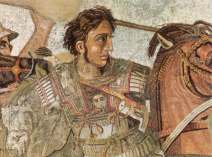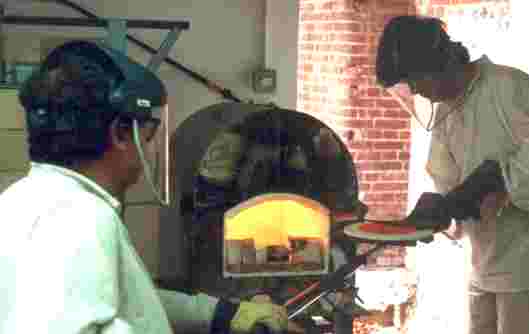
The Hellenistic Age began with the death of Alexander the Great in 323BC, and the division of his empire between his generals, in particular Macedon and Greece (The Antigonid dynasty), Syria and Mesopotamia (the Seleucids)
 and Egypt (The Ptolemys). The rivalries between these states were eventually overshadowed by the growth of the power and influence of Rome during the 2nd and 1st centuries BC.
and Egypt (The Ptolemys). The rivalries between these states were eventually overshadowed by the growth of the power and influence of Rome during the 2nd and 1st centuries BC.
In the climate of a culture steeped in Greek influences, this age saw the expansion of long distance trade throughout and beyond the Mediterrranean area, and many crafts, including glassmaking, flourished.
The first signs of a Hellenistic style of 'cast' glassware appeared in the second half of the 3rd century BC with the Canosa Group (from the find sites near Canosa di Puglia near the Adriatic coast of south east Italy) Many finds from this group originate from the Magna Graecia region of southern Italy or Sicily.
In the mid 2nd century BC this style expanded, and saw the development of 'cast' mosaic (polychrome) and monochrome vessels, and the establishment of workshops in locations around the eastern Mediterranean, including the Syro-Cypriot and Syro-Palestinian areas. This expansion laid the foundations for the rapid growth of glassmaking during the early Roman empire.

The Battle of Actium in 31BC saw the Hellenistic states finally brought under the aegis of the Roman Empire; Octavian (later known as Augustus) bringing Egypt under his control. This political unification allowed glassmaking, along with other industries, to flourish and develop rapidly. The industry benefitted from a vast expansion of trade as well as from the rapid spread of glassmakers and their knowledge from the eastern Mediterranean into Italy and beyond (either in their own right or as prisoners of war later sold into slavery).
Mosaic glass of these periods has often been identified as the 'vasa murrina' commented on in ancient references, including Pliny the Elder in his Natural History, but it appears that these vessels were ancient imitations of vessels carved from fluorspar. 'Murra' may have been the ancient name for this mineral, a translucent or opaque crystalline material occuring in pinks, violets and purples.
The archaeological record from this time shows a dramatic increase in the use of colour and complexity of pattern, with the use of strong, bright colours to decorate simple, useful vessel shapes becoming common.
All this was achieved using the simplest of hand-working manufacturing techniques, developed and improved through the Hellenistic period, and reaching their final development during the early Imperial times.
Ultimately, the quality of the glass vessels depended upon the skill and experience of the glassmakers and their ability to co-operate with one another. It involved several areas of specialisation: furnace technology, mouldmaking, glassmaking, hot glassworking and cold glassworking, and there was necessarily a certain amount of overlapping of these skills.
Making a 'cast' vessel necessitates a form (an internal mould of the vessel shape) over which it can be sagged. This requires potters' skills, and the technique was probably developed directly from core-forming technology.
For a monochrome vessel a glass disc is prepared either by gathering, ladling or pouring molten glass from a pot or crucible, and flattening it. For a polychrome vessel, a disc is arranged using previously prepared glass elements (strips, canes etc.), and fused. At this stage, if necessary, a network cane rim can be added by wrapping it around the edge of the hot disc.
The disc can then be shaped by slumping it over the form. (For a fuller description of these processes, see our Newsletters on the Archive Page.) If required, a pre-formed foot can be attached to the base when the shaped vessel is still on the form.

The hot-working stage outlined above is an active glassforming stage, needing the constant attention of at least two people. The disc has to be encouraged into the required shape, using simple tools. It is not, as has been argued, a mould-forming process.
After annealing, both sides of the cooled vessel need to be ground and polished to remove toolmarks and clay particles picked up during the forming process (see note above).
The category descriptions that we use are those set out by Grose in his comprehensive catalogue of ancient glass in the Toledo Museum of Art.
We use soda-lime glass of our own compositions. It is based on, and is extremely close to glass from the Hellenistic and early Imperial Roman periods. The methods we use, and the finish we impart (which is often of a higher quality than on many original vessels) are the result of research, experimentation and hard work. We believe that the techniques that we use are not that far removed from those of ancient glassmakers (taking into account the advantages of modern materials and equipment), and, as with all hands-on, craft-based work, there is no substitute for skill and experience. You will find details of these techniques in our Newsletters on the Archive Page.
The measurements of the vessels in the drawings are those of the vessels that we make, and represent typical dimensions within the groups of original vessels. The colours and cane cross-sections are directly based on those found in ancient glass, but we do not make exact copies of individual vessels. Each piece is unique, but typical of an original vessel of its type.